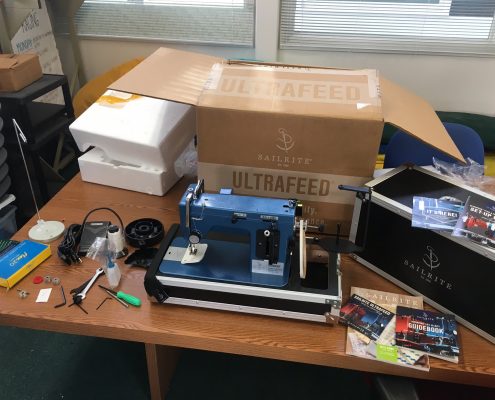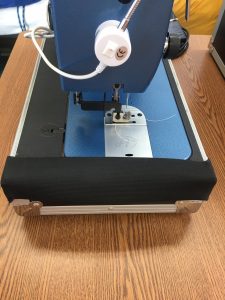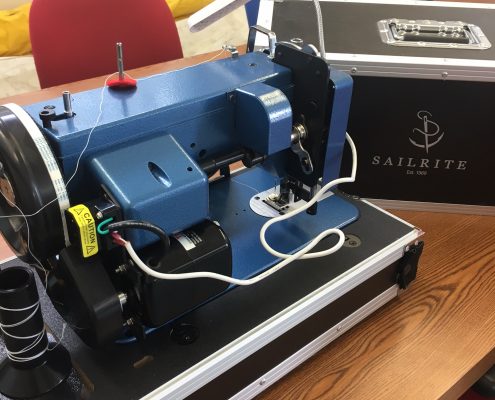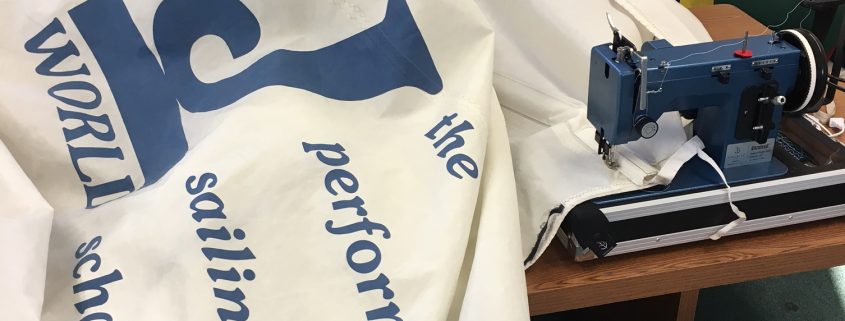We Are Sailin’ Rite!

Fixing a batten pocket on a J/80 Mainsail
As sailors, we cope with a lot of maintenance issues on the boats that we sail and race. Since there are so many moving parts and gear, the upkeep can get exhausting, and most of all, expensive! The relentless wind, sun and salt will eventually disintegrate our sails and covers, regardless of our protective measures. Canvas covers can help slow the degradation but inevitably the harsh elements will eat away at something. Most of the time, it’s simply the stitching that goes first.
If the stitching pulls out of a seam on a sail or cover, the situation can go downhill rapidly. The fabric can come unhemmed, allowing the material to degrade prematurely. It’s time consuming and costly to go to a sail loft or canvas repair shop to get it fixed. A simple repair that takes an hour or so, might take a week if the shop is backed up. Therefore, buying your own tools and educating yourself on small DIY repairs can save time and money. Obviously, there are certain projects that should be done by a professional, but for the do-it-yourselfer, it’s great to have your own tools and machinery to repair the old and build the new!
While there are many options on the market for proper sewing machines, Sailrite is one of the oldest and well-known brands out there. Thanks to a friend, I’ve recently had the opportunity to borrow an Ultrafeed LSZ-1 to repair some stitching on covers. I was so impressed with the ease and functionality, that my only choice was to acquire one for the J/World location in San Diego to help with repairs and new canvas for all our West Coast locations. The “Z” gives you the ability to switch from straight stitches to zig-zags, a necessary setting for sails!
 We ended up getting the Ultrafeed LSZ-1 PLUS, which came with its own carrying case, a magnetic light, and other great features. Just from the packaging, you can tell that Sailrite has things dialed in. Everything was well packaged; clearly with concentrated though and effort put into every detail. The machine was ready to go right out of the box, as each of the machine’s settings are tested before it’s sent out. The tester also left the piece of thread still run the correct way through the rig so I could see how it is run properly.
We ended up getting the Ultrafeed LSZ-1 PLUS, which came with its own carrying case, a magnetic light, and other great features. Just from the packaging, you can tell that Sailrite has things dialed in. Everything was well packaged; clearly with concentrated though and effort put into every detail. The machine was ready to go right out of the box, as each of the machine’s settings are tested before it’s sent out. The tester also left the piece of thread still run the correct way through the rig so I could see how it is run properly.
Along with the spare parts, extra bobbins, oil, small spool of thread, and other accessories, the kit came with a great instruction manual, CD-Rom with How-To videos, and a catalog. The simplicity in the layout and descriptions throughout the instructions and setup process speaks volumes to their time and experience in the industry. And of course they have any part you could ever need to repair or upgrade your machine.

Elastic strap for corners
It’s amazing how easy it is to get things set up on the machine immediately after opening. Once everything is in place, just step on the pedal and go! And, for different fabrics, you can put in the appropriate needle, easily tune the machine for that material, and get at it. Since the PLUS always sits in the base of the carrying case, there’s a potential for fabric to get caught and ripped on the metal corners. But fear not; Sailrite has noticed that too! They’ve included a durable elastic strap that buttons onto the end of the case to be placed over the corners while you’re sewing, eliminating the potential for snags and rips.
There are very few things that I’ve found with the machine that could be improved. As I said, they have things pretty well dialed. The bobbin (lower thread) system is great, especially for winding new thread onto it. My only complaint is that it doesn’t hold a whole lot of thread, so at times I’ve found that I’ll be in the middle of a stitch and have to reset everything. But they do include extra bobbins, so you can have them all wound up and it becomes a lot faster to change it out and continue on. It’s a small pill to swallow when the overall system is basically flawless. It’s truly something when you can have it so well tuned that you just step on the gas, and have the walking foot pull miles of fabric right through your guiding hands at any speed that you wish. If you want it to, it will go faster than you’re comfortable with.
One upgrade I did myself was to wire the light into the power system on the machine. I’m comfortable enough with my electrical skills to have tried it. What a success! Now only one plug is needed. While it’s probably not recommended by Sailrite; I was simply employing the DIY mentality. If you try it, be very careful, and certainly keep things unplugged when making connections!

Magnetic light wired into the electrical system.
Since receiving the machine after the new year, we’ve saved hundreds of dollars by repairing things ourselves. It’s mostly been repairing stitching in old covers, though the list has gotten quite long for new covers for various things throughout our West Coast locations! While I’ve mostly just been repairing covers, the sail repairs that I’ve done have proved that this machine can get through just about every material that you need! I’m really looking forward to learning new tricks and getting more efficient with the process. And of course I’ve used it to repair some clothes as well! If you’re looking for a fun new toy for this sailing season and to lower the bills, look no further than Sailrite!

Happy Sewing!
Patrick and the J/World Team






